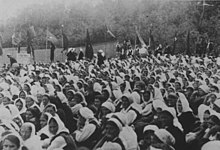Women's Antifascist Front of Bosnia and Herzegovina
It was established by the Communist Party in February 1942, over a year before the republic itself, with the aim of mobilizing women in Bosnia and Herzegovina into the Partisan resistance against the Nazi occupation of Yugoslavia.
It was one of the organizations which gave rise to the Women's Antifascist Front of Yugoslavia, the first congress of which was held in December 1942 in Bosanski Petrovac.
The Yugoslav anthropologist Vera Stein Ehrlich found that domestic violence was a common occurrence in Orthodox villages, as was bride kidnapping and rape.
Delegates from all liberated parts of Bosnia and Herzegovina were present, over 500 women altogether, mostly Serb Orthodox and Muslim peasants.
As only the Jewish and Orthodox population was targeted by the Ustašas, the Muslim women could move freely, which made them invaluable to the resistance movement.
Following the Partisans' defeat in the Fourth Enemy Offensive in March 1942, the AFŽ assumed complete responsibility for the resistance in the Herzegovinian town of Mostar.
In the Bosanska Krajina region, activists often undertook tours independently of Communist bodies, established their own treasuries, culture houses and apparatuses, and even formed a "women's municipality" in a village near Sanski Most.
Work among them was reported to be "very difficult" in the area of Grmeč mountain because of their tendency to "avoid contact with Serb [Orthodox] women" and because their husbands prohibited them from joining the organization.



